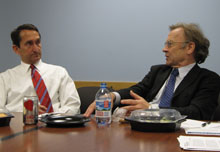
April 13, 2010 — At a Shorenstein Center Speaker Series event, Michael Tackett, Washington bureau chief for Bloomberg News, spoke about the “need for quality” while being “bombarded with information.”
In his talk, “News a Third Way: Substance and Speed in a World of Tweets,” Tackett provided a brief background of Bloomberg’s history. It began as an electronic data source for the financial industry, and has expanded to include entertainment and government news, with “2,000 reporters and editors around the world in about 145 bureaus.” He explained how Bloomberg strives to “provide 24/7 real-time news and information,” and all this “without a single Tweet — that I know of.”
Quoting a news editor, Tackett said that Bloomberg is proof that despite technological changes and progression, “a newspaper in some form will survive.” The reason for Bloomberg’s survival and success, Tackett suggested, is that it has employed a “third way” of distributing news: a “core subscription model” that also produces content “for a broader audience.”
When asked how Bloomberg is bridging the gap between free information and exclusive content for paying subscribers, Tackett said that the important thing is to focus on “what is really proprietary — what you have that nobody else has.” By providing premium financial content for a specific group of subscribers, Bloomberg is able to provide free content to a more general audience.
“Bloomberg is a very innovative company, but it’s also very old fashioned,” said Tackett. It is “very fact driven,” and “transparency about its sources is one of its real hallmarks.” Its goal is to be “factual first of all, but then to be first.” While this is a tall order in the midst of a constant stream of Tweets, Tackett is confident that “rich, fact-driven reports still have an honorable place in what we do.”
This article was written by Janell Sims and the photos taken by Heather McKinnon, both of the Shorenstein Center.

